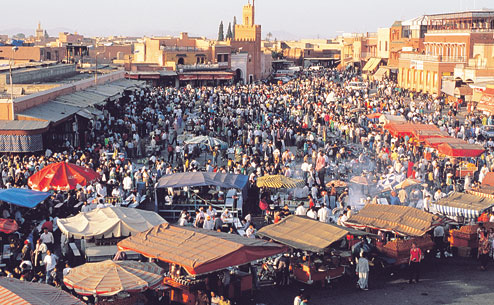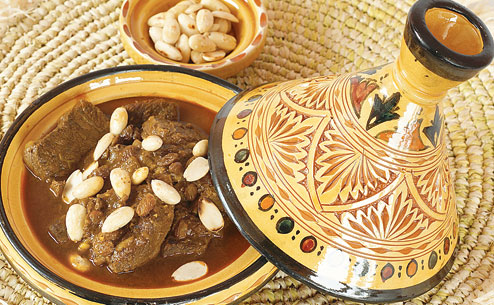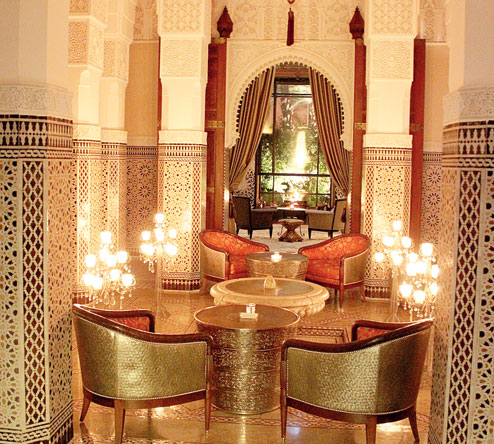Marrakech Magic

Morocco's culinary capital treats you to a round-the-clock flavour fest that's a gourmet's delight, says Hoihnu Hauzel
Deep inside Marrakech, the aroma of freshly brewed peppermint tea simply hangs in the air — at every street corner and practically everywhere that I go. It's the first drink I'm offered when I check-in at the hotel and it's what most shopkeepers use to lure shoppers and tourists into their shops yelling: "Come have some Moroccan tea — even if you don't buy anything."
In the lobby of Sofitel Marrakech where I'm staying, an old man occupies a corner with his tea-set and ingredients and serves tea to every guest through the day. He shreds the twigs from a bunch of peppermint, dunks the leaves in the waiting silver tea pot and pours the brew from a fair height into the waiting cup. "It tastes better if you do it this way," he says by way of explanation.
I arrived in Marrakech, the fourth largest city of Morocco in north Africa, looking forward to taking in an exotic land that's steeped in a rich history. I hit the city in the wee hours after an easy three-hour drive from Casablanca. But Marrakech, considered one of the busiest and most attractive tourist destinations in the Dark Continent, was wide awake. Bright-eyed tourists were everywhere — walking around its streets, chilling out in cafs, restobars and restaurants.
Being a former French protectorate — the French influence in Morocco continues to be strong and not knowing the language can prove to be a major handicap. Home to many fancy hotels including Richard Branson's famous Kasbah Tamadot, an hour's drive from the main city, Marrakech is a lively city of contrasts.
I discovered the city through the help of an all-knowing hotel concierge who gifted me a copy of the city food guide that eventually led me to places that I would never have been able to locate on my own.

The tagine, the funnel-shaped clay pot, is used to cook some traditional Moroccan dishes
I couldn't wait to learn more about tagine — the funnel-shaped clay cooking pot in which traditional Moroccan dishes are prepared.
My first stop was a lively place called Jad Mahal. The candles lit all along the wooden walkways of what looked like a private bungalow converted into an eatery, were enticing.
The ambience was electric what with the heavily draped curtains, sparkling chandeliers, framed mirrors, ornamented walls and psychedelic lights. I opted for tangia marrakchia de boeuf, mutton stew cooked slowly in the traditional clay bowl with saffron, cumin and the famous spice ras-el hanout, a special spice used for cooking mutton. Cheesecake with flavourful Moroccan dates rounded off the meal.
There's always something to cheer diners here. Like that evening when the mellow music was suddenly replaced by an Arabic tune. Out of nowhere sprang a group of belly dancers in harem-pants and flowy tunics. Some excited diners tucked crisp currency notes into their waistbands.
The next day I headed to the Piano Bar at the Royal Mansour Place, arguably the most luxurious hotel in Morocco. Built by the present king of Morocco, it's designed like a palace with riads (traditional old homes or palaces that had gardens or courtyards inside) and features private courtyards, hand-made Persian tile flooring and shimmering curtains. The bar is outfitted with furniture crafted in the finest ostrich leather. The platter of olives spiked with chillies, treated with ginger, herbs and oil were perfect to rev up my appetite.

The opulent Piano Bar at the Royal Mansour Place is outfitted with furniture crafted in ostrich leather; Pic by Hoihnu Hauzel
Another evening, I was charmed by La Mamounia, an 18th century resort. Surrounded by landscaped gardens, the resort sits in the middle of a 19-acre area. At the Moroccan restaurant, Le Morocain that's set discreetly in the spacious garden, the traditional version of lamb tagine was a revelation. The dish was inspired by the Berber style of cooking, the Berbers being indigenous people of Morocco who cook their meat with any vegetable that is available in their kitchens. So, my tagine arrived with carrots and potatoes along with the chunky meat just as the Berbers would cook it.
My gastronomic journey also took me to Villa des Orangers, an old riad that's converted into a boutique hotel. The resort owner, Pascal Beherec has left no stone unturned and transformed the old riad, built in the 1930s, into a charming place that's retained its original structure. Each of the rooms are done in different themes with antiques shipped from as far as Rajasthan and Malaysia.
I accessed the dining areas through layers of courtyards and fountains. Over the most delicate foie gras followed by ravioli tossed with lobster, I promised Pascal, my host for that evening that I would be back again for yet another delectable meal. But not until I washed down my meal with yet another cup of Moroccan tea.
TRAVEL LOG
Getting there: International carriers including Lufthansa, British Airways, Air India and Jet Airways fly to Marrakech.
Staying there: For the ultimate in luxury try Royal Mansour Place (http://www.royalmansour.com). Or check out La Moumunia (http://www.mamounia.com). For homely yet customised service there's Villa Des Orangers (www.villadesorangers.com)
https://www.telegraphindia.com/1130310/jsp/graphiti/16652348.jsp
The Telegraph, Sunday, March 10, 2013



